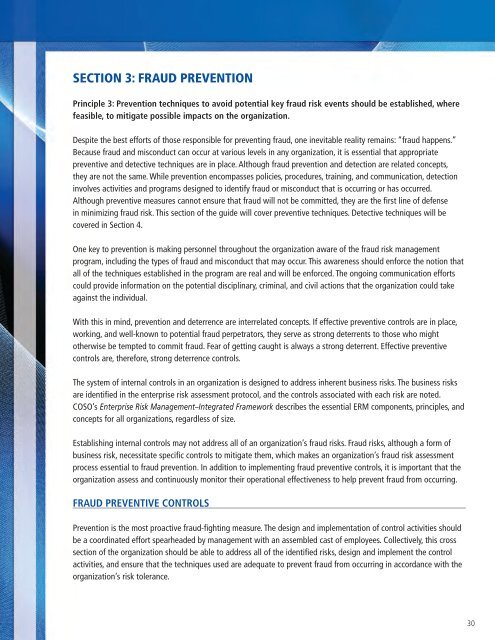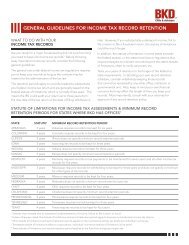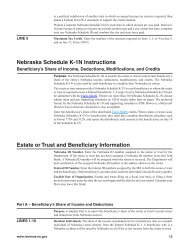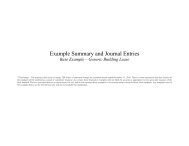eports and the monetary exposure may be similar at both organizations, the relative significance of <strong>fraud</strong>ulentexpense reports to the professional services firm may be greater, given the impact that <strong>fraud</strong>ulent expensereports can have on customer relationships. Organizations can categorize the significance of potential <strong>fraud</strong>s inas many buckets as deemed reasonable, but three categories are generally adequate: inconsequential, more thaninconsequential, and material.People/department — As part of the risk assessment process, the organization will have evaluated the incentivesand pressures on individuals and departments and should use the information gained in that process to assesswhich individuals or departments are most likely to have incentive to commit a <strong>fraud</strong>ulent act, and, if so, via whatmeans. This information can be summarized into the <strong>fraud</strong> risk assessment grid and can help the organization designappropriate risk responses, if necessary.Response to Residual Fraud RisksRisk tolerance varies from organization to organization. At the highest level, the board sets the organization’s risktolerance level, taking into consideration its responsibilities to all shareholders, capital providers, and stakeholders.While some organizations want only to address <strong>fraud</strong> risks that could have a material financial statement impact,other organizations want to have a more robust <strong>fraud</strong> response program. Many organizations will state that thereis a “zero tolerance” policy with respect to <strong>fraud</strong>. However, there may be certain <strong>fraud</strong> risks that an organizationconsiders too expensive and time-consuming to address via controls. Consequently, the organization may decide notto put controls in place to address such risks. If a <strong>fraud</strong> is discovered, zero tolerance for <strong>fraud</strong> will be applied.An organization’s risk tolerance level provides management s<strong>up</strong>port on how to respond to <strong>fraud</strong> risk. Fraud riskscan be addressed by accepting the risk of a <strong>fraud</strong> based on the perceived level of likelihood and significance,increasing the controls over the area to mitigate the risk, or designing internal audit procedures to address specific<strong>fraud</strong> risks. The board should ensure management has implemented the right level of controls based on the risktolerance it has established for the organization. In effect, one should look at an organization’s financial statementsand operations and ask “What can be wrong in this picture?”, and then design appropriate controls. The key isto be selective and efficient. There are probably thousands of potential controls that could be put in place. Thegoal is a targeted and structured approach — not an unstructured or haphazard approach — and efficientcontrols that deliver the most benefit for the cost of resources. The overall objective is to have the benefit ofcontrols exceed their cost.In addressing <strong>fraud</strong> risks, one should be careful to ensure that anti-<strong>fraud</strong> controls are operating effectively andhave been designed to include appropriate steps to deal with the relevant risks. Where an internal control mightbe executed with limited skepticism (e.g., agreeing an accrual balance to underlying s<strong>up</strong>port) an anti-<strong>fraud</strong> controlwould include an evaluation of the underlying s<strong>up</strong>port for consistency in application from prior periods and forpotential inappropriate bias. Therefore, anti-<strong>fraud</strong> controls should be designed appropriately and executed bycompetent and objective individuals. Management’s documentation of anti-<strong>fraud</strong> controls should include thedescription of what the control is designed to do, who is to perform the control, who is to monitor and assess theeffectiveness of the control, and the related segregation of duties.29
SECTION 3: FRAUD PREVENTIONPrinciple 3: Prevention techniques to avoid potential key <strong>fraud</strong> risk events should be established, wherefeasible, to mitigate possible impacts on the organization.Despite the best efforts of those responsible for preventing <strong>fraud</strong>, one inevitable reality remains: “<strong>fraud</strong> happens.”Because <strong>fraud</strong> and misconduct can occur at various levels in any organization, it is essential that appropriatepreventive and detective techniques are in place. Although <strong>fraud</strong> <strong>prevention</strong> and detection are related concepts,they are not the same. While <strong>prevention</strong> encompasses policies, procedures, training, and communication, detectioninvolves activities and programs designed to identify <strong>fraud</strong> or misconduct that is occurring or has occurred.Although preventive measures cannot ensure that <strong>fraud</strong> will not be committed, they are the first line of defensein minimizing <strong>fraud</strong> risk. This section of the guide will cover preventive techniques. Detective techniques will becovered in Section 4.One key to <strong>prevention</strong> is making personnel throughout the organization aware of the <strong>fraud</strong> risk managementprogram, including the types of <strong>fraud</strong> and misconduct that may occur. This awareness should enforce the notion thatall of the techniques established in the program are real and will be enforced. The ongoing communication effortscould provide information on the potential disciplinary, criminal, and civil actions that the organization could takeagainst the individual.With this in mind, <strong>prevention</strong> and deterrence are interrelated concepts. If effective preventive controls are in place,working, and well-known to potential <strong>fraud</strong> perpetrators, they serve as strong deterrents to those who mightotherwise be tempted to commit <strong>fraud</strong>. Fear of getting caught is always a strong deterrent. Effective preventivecontrols are, therefore, strong deterrence controls.The system of internal controls in an organization is designed to address inherent business risks. The business risksare identified in the enterprise risk assessment protocol, and the controls associated with each risk are noted.COSO’s Enterprise Risk Management–Integrated Framework describes the essential ERM components, principles, andconcepts for all organizations, regardless of size.Establishing internal controls may not address all of an organization’s <strong>fraud</strong> risks. Fraud risks, although a form ofbusiness risk, necessitate specific controls to mitigate them, which makes an organization’s <strong>fraud</strong> risk assessmentprocess essential to <strong>fraud</strong> <strong>prevention</strong>. In addition to implementing <strong>fraud</strong> preventive controls, it is important that theorganization assess and continuously monitor their operational effectiveness to help prevent <strong>fraud</strong> from occurring.Fraud Preventive ControlsPrevention is the most proactive <strong>fraud</strong>-fighting measure. The design and implementation of control activities shouldbe a coordinated effort spearheaded by management with an assembled cast of employees. Collectively, this crosssection of the organization should be able to address all of the identified risks, design and implement the controlactivities, and ensure that the techniques used are adequate to prevent <strong>fraud</strong> from occurring in accordance with theorganization’s risk tolerance.30
- Page 1 and 2: ACFE FRAUD PREVENTIONCHECK-UP
- Page 3 and 4: ACFE FRAUD PREVENTIONCHECK-UPThe Be
- Page 5 and 6: ACFE FRAUD PREVENTIONCHECK-UPACFE F
- Page 7 and 8: ACFE FRAUD PREVENTIONCHECK-UPACFE F
- Page 9 and 10: ACFE FRAUD PREVENTIONCHECK-UPACFE F
- Page 11 and 12: ACFE FRAUD PREVENTIONCHECK-UPACFE F
- Page 13 and 14: Sponsored by:The Institute of Inter
- Page 15 and 16: Team Members:Toby J.F. Bishop, CPA,
- Page 17 and 18: Managing the Business Risk of Fraud
- Page 19 and 20: establish their own fraud risk mana
- Page 21 and 22: Fraud risk identification may inclu
- Page 23 and 24: Thus, to properly address fraud ris
- Page 25 and 26: The board also has the responsibili
- Page 27 and 28: • Implementing adequate internal
- Page 29 and 30: Fraud Risk Management Program Compo
- Page 31 and 32: ecently been hired in the purchasin
- Page 33 and 34: Organizations can identify and asse
- Page 35 and 36: The Risk Assessment TeamA good risk
- Page 37 and 38: This also involves understanding th
- Page 39 and 40: - Invoices for goods not received o
- Page 41: Other RisksRegulatory and Legal Mis
- Page 45 and 46: An organization’s HR group is oft
- Page 47 and 48: SECTION 4: FRAUD DETECTIONPrinciple
- Page 49 and 50: Process ControlsProcess controls sp
- Page 51 and 52: keep such information confidential.
- Page 53 and 54: will vary depending on the nature,
- Page 55 and 56: Conducting the InvestigationPlannin
- Page 57 and 58: • Extended investigation — Cond
- Page 59 and 60: Fraud ControlsDeloitte Forensic Cen
- Page 61 and 62: APPENDIX B: SAMPLE FRAMEWORK FOR A
- Page 63 and 64: APPENDIX C: SAMPLE FRAUD POLICY 41N
- Page 65 and 66: CONFIDENTIALITYThe ______________ U
- Page 67 and 68: Sample Fraud Policy Decision Matrix
- Page 69 and 70: Identified Fraud Risksand Schemes (
- Page 71 and 72: 2) Misappropriation of:a) Tangible
- Page 73 and 74: ) Embezzlement(1) False accounting
- Page 75 and 76: Fraud Prevention Area, Factor, or C
- Page 77 and 78: Fraud Prevention Area, Factor, or C
- Page 79 and 80: Fraud Prevention Area, Factor, or C
- Page 81 and 82: Fraud Prevention Area, Factor, or C
- Page 83 and 84: O-Organization / PersonnelO1-Leader
- Page 85 and 86: O4.3 Enhance Operational Skills & C
- Page 87 and 88: PR-Prevent, Protect & PreparePR1-Ge
- Page 89 and 90: E-Periodic EvaluationE1-Evaluation
- Page 91 and 92: I2-CommunicationI2.1 Develop Commun
- Page 93 and 94:
CriminologyFraud Prevention Program
- Page 95 and 96:
CriminologyFraud Prevention Program
- Page 97 and 98:
CriminologyFraud Prevention Program
- Page 99 and 100:
CriminologyFraud Prevention Program
- Page 101 and 102:
CriminologyFraud Prevention Program
- Page 103 and 104:
CriminologyFraud Prevention Program
- Page 105 and 106:
CriminologyFraud Prevention Program
- Page 107 and 108:
CriminologyFraud Prevention Program
- Page 109 and 110:
CriminologyFraud Prevention Program
- Page 111 and 112:
CriminologyFraud Prevention Program
- Page 113 and 114:
CriminologyFraud Prevention Program
- Page 115 and 116:
CriminologyFraud Prevention Program
- Page 117 and 118:
Sample Fraud PolicyAssociation of C
- Page 119 and 120:
Sample Fraud PolicyCONFIDENTIALITYT
- Page 121 and 122:
Sample Fraud PolicyFraud Policy Dec
- Page 123 and 124:
Fraud’s Worst Enemyhttp://www.fra
- Page 125 and 126:
ACFE Insights - ACFE Insightshttp:/
- Page 127:
ACFE Insights - ACFE Insightshttp:/









